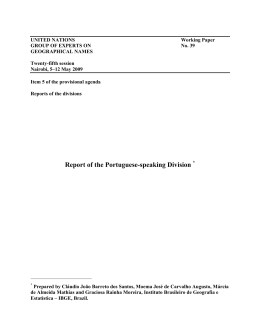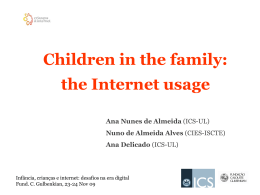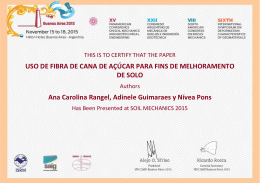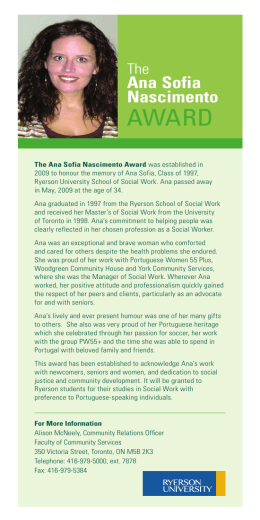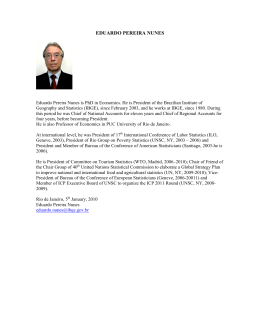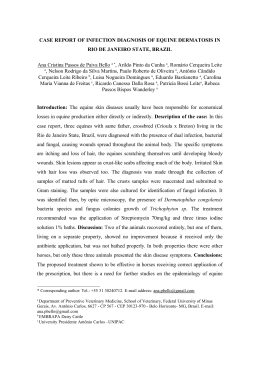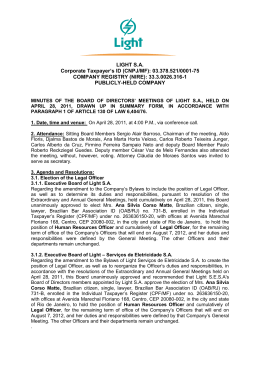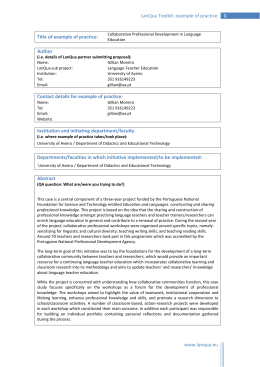UNITED NATIONS GROUP OF EXPERTS ON GEOGRAPHICAL NAMES Working Paper No. 43 Twenty-fifth session Nairobi, 5–12 May 2009 Item 9 of the provisional agenda Activities relating to the Working Group on Training Courses in Toponymy Cooperation Brazil-Canada in Training and Designing a Sustainable Program for the Standardization of Geographical Names in Brazil * * Prepared by Ana Maria Goulart Bustamante and Vania de Oliveira Nagem, Instituto Brasileiro de Geografia e Estatística - IBGE, and Carlos José Galvão Corrêa (Brazil). Title: Cooperation Brazil-Canada in Training and Designing a Sustainable Program for the Standardization of Geographical Names in Brazil Abstract: The Course “Introduction to standardization of Geographical Names” (CINGE 2008) held in Rio de Janeiro, Brazil, from November 26 th to 28 th , 2008, enrolled more than fifty students and had the special participation of invited in-house speakers and of Helen Kerfoot, UNGEGN’s chairperson, thanks to the support of the Demonstrative Project # 6 of PIGN (Projeto de Infra-estrutura Geoespacial Nacional – National Geospatial Infrastrucutre Project), a cooperation Canada-Brasil. Previous support of PIGN was reported by Canadian experts in a technical paper submitted in the Twentythird session of UNGEGN, when the same Brazil-Canada project supported the printed material that complemented the first geographical names course offered by the program started in 2004 in Brazil. The course had the supervision of professor Maria Vicentina de Paula do Amaral Dick, of the University of São Paulo (USP), leading researcher of the “Toponymic Atlas” of Brazil and other regions, a project registered in the National Technological Development Research Council (CNPq). The Sustainable Program for the Standardization of Geographical Names in Brazil was proposed by the Coordination of Cartography of the Brazilian Institute of Geography and Statistics (IBGE) in 2008 and involves training initiatives such as the successful first course offered by the Training Coordination of IBGE in 2007, as well as the other four courses, two of which in 2008, offered in accordance with the needs, which made it possible to start in 2008 the program with local support of special agencies of IBGE. If more resources are available, more courses will be promoted with local support from the special agencies. During the course, PhD professors Ana Maria Goulart Bustamante and Maria Vicentina de Paula do Amaral Dick showed the first results of the Toponymy and Terminology project, supported by IBGE and USP, as it is being reported to UNGEGN’s Working Group on Toponymic Terminology. Printed material and a compact disk with computer files of contents of the CINGE 2008 were prepared for the students and invités with the support of PIGN Demonstrative Project # 6 on environment. The Brazilian Project is thnakful to Helen Kerfoot, who authorized the publishing of the contents of her presentations at the course, translated to Portuguese and in Power Point files, which were going to be hosted until the end of April 2009 in the internet by courtesy of www.toponimia.org. 2 The Course “Introduction to standardization of Geographical Names” started on November 26 th , 2008 and lasted until November 28 th , involving more than fifty students in Rio de Janeiro, Brazil, workers of both IBGE and other institutions, among them state government officials from Paraná, in the south of the country, the Academy of Letters, local cartography institutions. Participants were mostly IBGE permanent workers, but more than one third of the students enrolled came from other institutions, such as Instituto Pereira Passos, responsible for the cartographic products of the City of Rio de Janeiro, and the Environmental and Planning secretariats of the state government of Paraná. The course had the special participation of Helen Kerfoot, UNGEGN’s chairperson, thanks to the support of the Demonstrative Project # 6 of PIGN, first reported by Canadian experts in a technical paper submitted in the Twenty-third session, when the same Canadian project supported the printed material that complemented the first geographical names course offered in the program started in 2004 in Brazil. The course had the supervision of professor Maria Vicentina de Paula do Amaral Dick, of the University of São Paulo (USP), leading researcher of the “Toponymic Atlas” of Brazil and other regions©. The name of Helen Kerfoot is the first in a list of many strong supporters and visitors to whom the people involved in the Brazilian program is very grateful, starting with Dave Carney, project consultant, and Moema Augusto, vice-chair of the Portuguese-speaking Division of UNGEGN, as well as the Director of Geosciences Luiz Paulo Fortes, the president of IBGE, Eduardo Pereira Nunes, and professor Maria Vicentina de Paula do Amaral Dick. Moema Augusto is the Brazilian expert who has led the recent efforts that, in a period of three years, have brought to this point the planning of the Brazilian National Program of Standardization of Geographical Names. Dave Carney is a resourceful partner who is making a great difference also with strong ideas such as the theme of sustainability associated with geographical names standardization. The Sustainable Program for the Standardization of Geographical Names in Brazil was proposed in 2008 by experts of the Cartography Coordination of IBGE and involves training initiatives such as the successful first course offered by the Training Coordination of IBGE in 2007, as well as the other four courses, two of which in 2008, offered in accordance with the institutional needs, which made it possible to start in 2008 the program with the local support of special agencies of IBGE. If more resources are available, more courses will be promoted with local support from the special agencies. The program is very thankful to the efficiency of the Training Coordination of IBGE, led by Dr. Sandra Furtado, who was sensible to the needs of the theme, together with the Training Coordination Committee. Among its members, we highlight the support of the chairperson, professor José Matias Lima, Sonia Albieri, Sonia Val, Monica O´Neill and Luiz Felipe Louzada (executive secretary). Around fifty people participated fully in the twenty-hour Course “Introduction to Geographical Names Standardization” (CINGE08) and received the printed material and a compact disk with computer files prepared with the support of PIGN Demonstrative Project # 6. Helen Kerfoot’s presentations during the course, translated to Portuguese 3 and in Power Point files, were to be hosted as a courtesy until the end of April 2009 at www.toponimia.org, as were the nice and informative posters she brought as contributions for the workshop. Toponimia.org is an initiative of the civil society led by the dictionary system designer and analyst Carlos José Galvão Corrêa, another expert invited to speak in the CINGE 2008. On the first day, Helen Kerfoot invited the participants to solve the quiz “Where is it located?” and gave gifts to the two participants that had the greatest number of correct answers about the names of the places where the signs pictured were located. The agenda first drafted for the course is presented in the next pages, as well as the list of collaborators and supporters, all of which deserve a warm note of thanks for their decisive contribution from all those involved in the Brazilian program of geographical names. 4 Course “Introduction to standardization of Geographical Names” min. 1st Day – November 26 th , 2008 – 8h to 12h, 13h to 17h 10 Welcome and instructions from organizers ENCE 20 Presentation of the course. Technological innovation, environmental management and standardization of geographical names. 20 30 National Infrastructure of Spatial Data (NISD)and National Committee of Cartography (CONCAR): advances in standardization of geographical names in Brazil and Portuguese-speaking countries. Toponymic Atlas of Brazil and cultural marks. Vania Nagem and Ana Bustamante Moema Augusto 10 Terminology and Toponymy Project IBGE-USP: classes by Dick (1990). 40 Introduction to standardization of geographical names and how UNGEGN works in the UN system (Unstats and EcoSoc). Break Helen Kerfoot Proposals of Brazil and the Portuguese-Speaking Division for the Working Groups of UNGEGN. Brazilian Gazetteer of locations with more than 100.000 inhabitants for the UNGEGN Database. Moema Augusto 15 15 20 30 Models of National Authorities: Geographical Names and NISD. 20 Sistematization of the presentations. Spelling, categories and reference points for territorial areas. Context (source and date of data). Quiz. Where is it located? 10 Maria Vicentina Dick Ana Bustamante ENCE Cláudio João, Márcia Mathias, Ana Bustamante Helen Kerfoot Ana Bustamante Helen Kerfoot Break (lunch time) 20 Technical specifications for gazetteers and national guidelines. 30 Guidelines and the multiple uses of geographical names and gazetteers. Vania Nagem and Ana Bustamante Helen Kerfoot 30 Issues regarding classification of types of features. Vania Nagem 20 Issues regarding classification of types of features. Examples from Canada. Helen Kerfoot 25 Issues on the positioning of named features. SIRGAS2000. Vania Nagem 15 Break ENCE 30 Spelling issues. The new standards for all Portuguese Language countries. Ana Bustamante 30 Indications for guidelines regarding issues on language standards. Ana Bustamante 5 30 15 15 15 30 30 15 15 15 20 20 20 30 Sistematization of presentations and main issues. Compiling of indications for guidelines and national authority. Course “Introduction to standardization of Geographical Names” 2nd Day – November 27th 2008 Workshop “Geographical Names and environment” – 8h to 12h Course “Introd. to standardization ...” – 13h to 17h (field practice) Opening ceremony: officials from IBGE and PIGN. Moema Augusto, coord. Of Cartography (15 minutes) presents professor Maria Vicentina Dick, of USP and Dave Carney, of PIGN Opening ceremony by PIGN representative: Dave Carney (15 minutes) presents emeritus scientist of NRCan, Helen Kerfoot, chairperson of UNGEGN Presentation of DP#6 of PIGN. From aerial pictures to thematic maps. Innovation in the products: Gazetteer of the Chart Rio Dourado. Geodetic survey stations and geographical names. Protection by law, certification and naming of GPS stations and marks. “Nostalgia Network” of CGED. Old stations in elevations and new requirements for GPS stations. Checking the state of stations in land. Networking. DP#6 and contributions to environmental management: aerial photos, geodetic station, 3D model of elevation: echological corridors aplication. Standards for naming topographic chats: Rio Dourado or Reserva Biológica União? Environmental management in the state of Rio de Janeiro: echological mosaics from ortophotocharts with toponyms Possible follow up actions. Project Geodetic Survey Monuments and other follow up actions from new mapping and uses for the ortophotochart with toponyms (scale 1:10.000), in partnership with IBGE Project “Pé de pé” (“Standing still”), of Otávio Avancini. Proposal of Geodetic Survey Monuments Project for SIRGAS2000 Informes dos organizadores / Intervalo Introduction to standardizationof geogaphical names. The Group of Experts and the countries participation. Models of national authorities on greographical names (and its relations with statistcs) National Comittee of Cartography – CONCAR as ruling body for NISD: classification of features, SIRGAS2000 and the proposal to create the Committee of Geographical Names. Toponymy and environment in Edward Sapir´s work. Helen Kerfoot and Ana Bustamante DGC, ENCE, CCAR PIGN (Dave Carney) Vania Nagem and Ana Bustamante Vania Nagem (and invités from CGED) Vania Nagem (and invités from CCAR) Vania Nagem (and invités from ReBio União) Ana Bustamante Helen Kerfoot Helen Kerfoot Moema Augusto Maria Vicentina Dick Break – Lunch 10 Inviation for field practice and instructions (meeting of participants to leave for the field) Field practice: checking the situation of the stations in land and limits and boudaries. Support. Toponymy and microtoponymy. Introduction to GPS and to SIRGAS2000. Ana Bustamante CGED and CCAR 6 3rd. Day – November 28th, 2008 – 8h to 12h, 13h to 17h 30 Indigenous toponymy in the University of São Paulo. Ethnolinguistics and toponymic motivation. Maria Vicentina Dick 30 Indigenous toponymy in Canada. Helen Kerfoot 30 Rendering of toponyms. Standardization and national guidelines. Composition of gazetteer and database. Gazetteers and reference works (glossaries and dictionaries). Spelling of indigenous names: public policies regarding indigenous names. Break Ana Bustamante 30 15 35 Sources for geographical names and characteristics. Standardization and studies for special thematic gazetteers. 30 Database for multiple uses and/or users. Problems of the alphabetical order, design of the output and of standardization (x identity). Glossaries for UNGEGN, USP and BNGB (limits and spatial divisions) 40 Helen Kerfoot ENCE Ana Bustamante and Carlos Galvão Corrêa Carlos Galvão Corrêa Ana Bustamante and invité Break (lunch) 50 Review of main concepts presented. 50 Sistematization of field work 50 Processes workshop 15 Break Vania Nagem and Ana Bustamante Vania Nagem and Ana Bustamante Vania Nagem, Ana Bustamante and Carlos Galvão Corrêa ENCE 15 Quiz. Where is it located? Results and prizes. Helen Kerfoot 30 Comments on the course and recommendations All 30 Closing ceremony Helen Kerfoot, Dave Carney, Maria Vicentina, Moema Augusto 7 Curso Introdução à padronização de nomes geográficos (20 horas) 26, 27 e 28 de novembro de 2008 Atividade complementar: Workshop Nomes Geográficos e Meio Ambiente (4 horas) Coordenação e pesquisa/Coordination and Research: Vania de Oliveira Nagem, Coordenação de Cartografia (CCAR) do IBGE Ana Maria Goulart Bustamante (Nomes Geográficos, CCAR-IBGE) Realização/Project partners: Projeto Nomes Geográficos da Coordenação de Cartografia (da DGC-IBGE) Projeto Piloto Nomes Geográficos e Meio Ambiente (do PD#6 do PIGN, CCAR e CREN) Projeto Terminologia e Toponímia IBGE-USP (apoio: CCT do IBGE, FFLCH da USP) Supervisão de Maria Vicentina de Paula do Amaral Dick ENCE – Coordenação de Treinamento e Aperfeiçoamento Material didático/Course materials Edição/Publishing and editing: Ana Maria Goulart Bustamante (Nomes Geográficos, CCAR-IBGE) Carlos José Galvão Corrêa (GSE - Galvão Soluções Editoriais) Produção do material didático/Course materials production: GSE – Galvão Soluções Editoriais Centro de Referência em Nomes Geográficos – Coordenação de Cartografia – DGC – IBGE Projeto Demonstrativo #6 do PIGN – Projeto da Infra-estrutura Geoespacial Nacional Agradecimentos/Special thanks to: Moema José de Carvalho Augusto, Celso José Monteiro Filho Cristina Lobianco Luiz Paulo Fortes Patrícia Vida Sandra Márcia Melo Sandra Furtado Luciene Gallart (e todos da ENCE – CTA) Carlos Galvão Corrêa Pessoal da Reserva Biológica União CGED GATs Comitê de Coordenação de Treinamento (CCT) Agradecimentos aos convidados especiais/Special thanks to invited speakers: Helen Kerfoot (presidente do UNGEGN – United Nations Group of Experts on Geographical Names /Grupo de Peritos das Nações Unidas em Nomes Geográficos) Dave Carney (consultor do PIGN – Projeto Demonstrativo 6: Meio Ambiente) Maria Vicentina Dick (professora de Toponímia Indígena e Etnolingüística da FFLCH da USP) 8 PIGN – PD#6 * Evento complementar (4 horas) Rio de Janeiro, 27 de novembro de 2008 Nomes Geográficos e Meio Ambiente (Workshop) 9
Download
